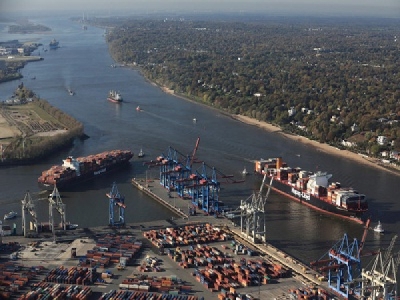
Posted on November 20, 2017
By Greg Knowler, JOC.com
The Port of Hamburg has labeled the inability of mega-ships to call and leave fully loaded because of draught restrictions on the Elbe River a “blockade” by environmentalists holding up the deepening work that was hurting the port and damaging the economy.
Joint Port of Hamburg Marketing CEO Ingo Egloff said the objections from environmental and other organisations appeared to have the ultimate aim of scrapping the dredging altogether.
“In doing so, they wholly ignore the damage to the national economy caused by a blockade that has already lasted years and the additional adverse economic effects on the further development of the port and the jobs involved,” he said.
Egloff expressed frustration that the vital infrastructure project was being blocked by objections from environmental pressure groups, calling it unacceptable. “It is becoming increasingly difficult for us to explain to the port’s international customers how we are still having to wait for implementation of fairway dredging despite the qualified planning approval granted in 2012 and the February 2017 decision of the Federal Administrative Court,” said Egloff.
Environmental opposition to deepening the Elbe is holding up plans to dredge about 130 km of the river that, once complete, will enable the mega-ships with a draught of 14.5 meters to reach the port, one meter deeper than the current draught.
That will enable mega-ships to access Hamburg’s terminals, crucial if the port is to remain competitive among its North Europe peers. Container lines are deploying ever-larger vessels on the Asia-Europe trade, a trend that has seen the Port of Hamburg this year handling almost 90 percent more calls by ships with capacity of 18,000 to 20,000 TEU and above.
The Port of Hamburg’s marginal 0.4 percent growth in container throughput from January through September was blamed on the inability of mega-ships to call and leave Hamburg optimally loaded. Restrictions on the river and limited tidal windows force carriers to prioritise the transport of full containers on their giant vessels, with empties being routed via other hubs in North Europe.
The port handled 6.8 million TEU in the first nine months of the year, up a marginal 0.4 percent compared with the same period in 2016. Of this amount, 5.8 million was loaded containers that grew 1.2 percent, but empties totalled 924,000 TEU, a year-over-year decline or 4.3 percent.
Axel Mattern, joint Port of Hamburg Marketing CEO, said the downturn in empty box handling was a result of yet to be implemented dredging of the Elbe fairway. “Market research by Port of Hamburg Marketing indicates that restrictions on the Elbe applying to Hamburg, plus limited tidal windows, are causing shipping companies to use available slot space on their mega-containerships for loaded boxes as a matter of priority. Empty containers are increasingly being routed via other ports in Northern Europe,” Mattern said.
Among Europe’s major ports, Hamburg’s container throughput features the lowest proportion of empty boxes at 13.7 percent, and at 86.3 percent, the highest for loaded containers.
Egloff said dredging the Elbe was essential for Hamburg and should not be delayed any longer, and he highlighted the benefits of the project. “Higher draft and improved opportunities for passing on the Elbe will offer increased safety and flexibility for traffic control on the Elbe, also producing tremendous advantages for merchant shipping,” he said.
“Mega-containerships will be able to bring and take away an additional 1,600 and more TEU per call to and from Hamburg.”
Of the 6.8 million TEU handled in Hamburg in the first nine months, 3.5 million TEU were import containers (up 0.7 percent) and 3.2 million TEU were export containers (up 0.1 percent). The upward trend in container traffic with China, Hamburg’s leading trade partner by a wide margin, was maintained, with 2.5 percent growth to 2 million TEU.
The fierce competition for international container traffic has seen some North Europe ports benefiting more than others from the changing schedules of the new alliances that launched on April 1. Rotterdam was one of the major beneficiaries and posted a record third quarter and a 10 percent increase in nine-month container throughput to 10.2 million TEU.
The Port of Antwerp reported a some of its best-ever container handling figures in the second and third quarters of 2017, and despite falling transshipment handled 7.8 million TEU through September, a year-over-year increase of 3.2 percent in the first nine months of the year.
Antwerp has slipped further behind Rotterdam, but the Belgian port has widened its lead over Hamburg, which it ousted as Europe’s second-largest container hub a few years ago.
Source: JOC.com





